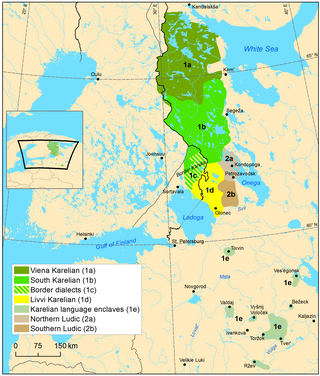Top Qs
Timeline
Chat
Perspective
Livvi-Karelian language
Karelian dialect spoken in Russia and Finland From Wikipedia, the free encyclopedia
Remove ads
Livvi-Karelian[6] (Alternate names: Liygi, Livvi, Livvikovian, Olonets, Southern Olonetsian, Karelian; Russian: ливвиковское наречие, romanized: livvikovskoye narechiye)[6][7] is a supradialect of Karelian, which is a Finnic language of the Uralic family,[8] spoken by Olonets Karelians (self-appellation livvi, livgilaizet), traditionally inhabiting the area between Ladoga and Onega lakes, northward of Svir River.
You can help expand this article with text translated from the corresponding article in Finnish. (May 2021) Click [show] for important translation instructions.
|
The name "Olonets Karelians" is derived from the territory inhabited, Olonets Krai, named after the town of Olonets, named after the Olonka River.
Remove ads
History

Before World War II, Livvi-Karelian was spoken both in Russia and in Finland, in the easternmost part of Finnish Karelia. After Finland was forced to cede large parts of Karelia to the USSR after the war, the Finnish Livvi-Karelian population was resettled in Finland. Today there are still native speakers of Livvi-Karelian living scattered throughout Finland, but all areas in which Livvi-Karelian remains a community language are found in Russia.
Speakers of Livvi-Karelian may be found mainly in Olonetsky, Pryazhinsky, Pitkyarantsky, and partly Suoyarvsky districts of the Republic of Karelia.[9] Livvi-Karelian long remained relatively uninfluenced by the Russian language despite the large influx of Russians following the founding of Saint Petersburg in 1703.[citation needed]
Remove ads
Phonology

Vowels
Consonants
Remove ads
Alphabet
Livvi-Karelian uses the Latin alphabet and has the following letters in its alphabet, which is called the Karelian alphabet: Aa, Bb, Cc, Čč, Dd, Ee, Ff, Gg, Hh, Ii, Jj, Kk, Ll, Mm, Nn, Oo, Pp, Rr, Ss, Šš, Zz, Žž, Tt, Uu, Vv, Yy, Ää, Öö.[11]
Until 2007, the ü letter was a part of the Livvi-Karelian alphabet, which has been recommended by the Karelian language board to be instead be changed to the y letter.[12]
Grammar
Livvi-Karelian and its grammatical cases are quite similar to the Finnish language and other related Finnic languages.
The word 'food' in Livvi-Karelian cases:[13]
Remove ads
Common phrases
Hello! - Terveh!
How are you? - Kuibo dielot?
Good night! - Hyviä yödy!
Good afternoon! - Hyviä päiviä!
Do you speak Karelian? - Pagizetgo (sinä) karjalakse?
I'm sorry. - Minul on žiäli.
You're welcome. - Ole hyvä.
I love you. - Suvaičen sinuu.
Goodbye. - Jiä tervehekse.
My name is ... - Minun nimi on ...
Excuse me. - Prostikkua.
Help! - Avvutakkua!
Cheers! - Teijän tervehyökse!
Right. - Oigei.
Left. - Hurai.
Yes. - Da.
No.. - Ei.
One. - Yksi.
Two. - Kaksi.
Three. - Kolme.
Four. - Nelli.
Five. - Viizi.
Remove ads
See also
References
External links
Wikiwand - on
Seamless Wikipedia browsing. On steroids.
Remove ads


